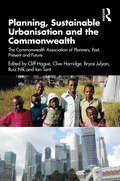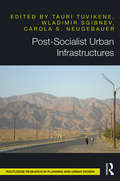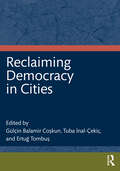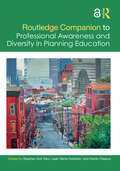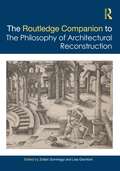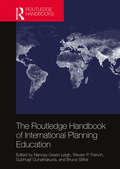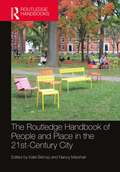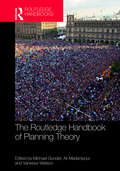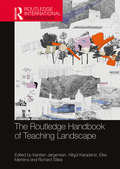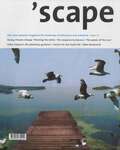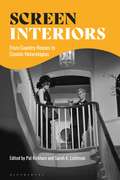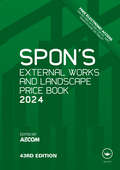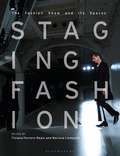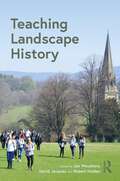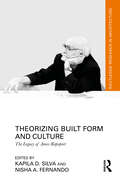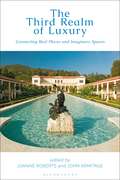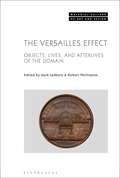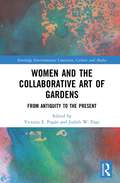- Table View
- List View
Planning, Sustainable Urbanisation and the Commonwealth: The Commonwealth Association of Planners, Past, Present and Future
By 2050, an additional 2.5 billion people will be living in the world’s towns and cities, almost 50% of them in the 56 Commonwealth countries. To a significant extent, the future of the planet hangs on how cities and human settlements are managed. It is in our cities that the emissions creating climate catastrophe are stoked and where change can – and must – make a difference at scale. Food security, water, basic services, migration, shelter, jobs, environment: sustainable urbanisation is about changing direction to strive for a fairer and less environmentally damaging future. This well-illustrated book by authors from around the Commonwealth tells how the Commonwealth Association of Planners across five decades has campaigned to make a difference. It also looks ahead, scoping the urgent, practical action that is now required.
Post-Socialist Urban Infrastructures (OPEN ACCESS)
Post-Socialist Urban Infrastructures critically elaborates on often forgotten, but some of the most essential, aspects of contemporary urban life, namely infrastructures, and links them to a discussion of post-socialist transformation. As the skeletons of cities, infrastructures capture the ways in which urban environments are assembled and urban lives unfold. Focusing on post-socialist cities, marked by neoliberalisation, polarisation and hybridity, this book offers new and enriching perspectives on urban infrastructures by centering on the often marginalised aspects of urban research—transport, green spaces, and water and heating provision. Featuring cases from West and East alike, the book covers examples from Azerbaijan, Bulgaria, Serbia, Croatia, Germany, Russia, Georgia, Lithuania, Poland, the Czech Republic, Tajikistan, and India. It provides original insights into the infrastructural back end of post-socialist cities for scholars, planners and activists interested in urban geography, cultural and social anthropology, and urban studies.
Reclaiming Democracy in Cities
Effective urban governance is essential in responding to the challenges of inequality, migration, public health, housing, security, and climate change. Reclaiming Democracy in Cities frames the city as a political actor in its own right, exploring the city’s potential to develop deliberative and participatory practices which help inform innovative democratic solutions to modern day challenges.Bringing together expertise from an international selection of scholars from various fields, this book begins with three chapters which discuss the theoretical idea of the democratic city and the real-world applicability of such a model. Part II discusses new and innovative democratic practices at the local level and asks in what way these practices help us to rethink democratic politics, institutions, and mechanisms in order to move toward a more egalitarian, pluralist, and inclusive direction. Drawing on the Istanbul municipal elections and the Kurdish municipal experience, Part III focuses on the question of whether cities and local governments can lead to the emergence of strong democratic forces that oppose authoritarian regimes. Finally, Part IV discusses urban solidarity networks and collaborations at both the local level and beyond the nation, questioning whether urban solidarity networks and alliances with civil society or transnational city networks can create alternative ways of thinking about the city as a locus of democracy.This edited volume will appeal to academics, researchers, and advanced students in the fields of urban studies, particularly those with an interest in democratic theory; local democracy; participation and municipalities. It will also be relevant for practitioners of local governments, NGOs, and advocacy groups and activists working for solidarity networks between cities.
Romany caravan (Large Print)
This image shows the side view of a painted Romany caravan. There is a locator dot shown, which will be at the top left of the page when the image is the right way up. At the lower left of the image, four steps lead up to a door at the rear end of the caravan, which is not visible in this image. To the right of the steps at the bottom of the image, two of the caravan's four spoked wheels can be seen with the larger on the left. Above the small wheel on the right is the supporting frame upon which the axle turns. The axle cannot be shown. Above the wheels, decorative columns are shown on the panelling of the caravan, leading up to two windows with open shutters. The painted wooden roof sticks out beyond the body of the caravan at the top of the image, particularly at the back.
Romany caravan (UEB Contracted)
This image shows the side view of a painted Romany caravan. There is a locator dot shown, which will be at the top left of the page when the image is the right way up. At the lower left of the image, four steps lead up to a door at the rear end of the caravan, which is not visible in this image. To the right of the steps at the bottom of the image, two of the caravan's four spoked wheels can be seen with the larger on the left. Above the small wheel on the right is the supporting frame upon which the axle turns. The axle cannot be shown. Above the wheels, decorative columns are shown on the panelling of the caravan, leading up to two windows with open shutters. The painted wooden roof sticks out beyond the body of the caravan at the top of the image, particularly at the back.
Romany caravan (UEB uncontracted)
This image shows the side view of a painted Romany caravan. There is a locator dot shown, which will be at the top left of the page when the image is the right way up. At the lower left of the image, four steps lead up to a door at the rear end of the caravan, which is not visible in this image. To the right of the steps at the bottom of the image, two of the caravan's four spoked wheels can be seen with the larger on the left. Above the small wheel on the right is the supporting frame upon which the axle turns. The axle cannot be shown. Above the wheels, decorative columns are shown on the panelling of the caravan, leading up to two windows with open shutters. The painted wooden roof sticks out beyond the body of the caravan at the top of the image, particularly at the back.
Routledge Companion to Professional Awareness and Diversity in Planning Education
The Routledge Companion to Professional Awareness and Diversity in Planning Education engenders a discourse on how urban planning as a discipline is being made attractive to children and youth as they consider their career preferences. It also provides a discourse around the diversity challenges facing the institutions for training urban planning professionals.This Companion is an impressive collection of initiatives, experiences, and lessons in helping children, youth, and the general public appreciate the importance of, and the diversity challenge confronting, the urban planning profession and education. It comprises empirical, experimental, and case study research on initiatives to address the professional awareness and diversity challenges in urban planning. It has uniquely assembled voices and experiences from countries in Africa, Asia, Europe, and North America. Contributors are educators, practitioners, and activists of urban planning as well as policymakers in their respective countries.This Companion is intended as a resource for urban planning schools and departments, foundations, non-profit organizations, private sector organizations, public institutions, teachers, and alumni, among others to learn and consciously drive efforts to increase planning education awareness among children, youth, and the general public.Chapter 6 of this book is freely available as a downloadable Open Access PDF at http://www.taylorfrancis.com under a Creative Commons Attribution-Non Commercial-No Derivatives (CC-BY-NC-ND) 4.0 license.
The Routledge Companion to the Philosophy of Architectural Reconstruction
This companion investigates the philosophical and theoretical foundations determining the conditions of possibility and the limits that make the conservation, readaptation, and transformation of past buildings legitimate operations.As increasing ecological and economic challenges question opportunities for new construction, the process of restoring, transforming, and readapting buildings for new or continued use is becoming an essential part of architectural practice. At the same time, the role of building conservation is changing from mere material preservation to being part of a broader strategy for social regeneration, eco-awareness, and inclusive urban planning. Chapters of this volume explore the complex set of considerations that inform decisions to merely preserve, accurately restore or variously reuse a building. They also look at the broader philosophical concerns such as ethical and aesthetic values, combined with ideas of heritage, history, and collective identity. Case studies on reconstruction after war, gentrification, the restoration of ancient edifices, reconstruction following the effects of climate change, and the use of technology solutions among many others, make this a timely and urgent volume.Adopting a broad transcultural perspective with contributions from five continents, the volume combines theoretical approaches with more practical, case study-based investigations and will be of great interest to upper-level students and academics working in the fields of architecture, conservation, urban design, aesthetics, and heritage management.
The Routledge Handbook of International Planning Education
The Routledge Handbook of International Planning Education is the first comprehensive handbook with a unique focus on planning education. Comparing approaches to the delivery of planning education by three major planning education accreditation bodies in the United States, Australia, and the United Kingdom, and reflecting concerns from other national planning systems, this handbook will help to meet the strong interest and need for understanding how planning education is developed and delivered in different international contexts. The handbook is divided into five major sections, including coverage of general planning knowledge, planning skills, traditional and emerging planning specializations, and pedagogy. An international cohort of contributors covers each subject’s role in educating planners, its theory and methods, key literature contributions, and course design. Higher education’s response to globalization has included growth in planning educational exchanges across international boundaries; The Routledge Handbook of International Planning Education is an essential resource for planners and planning educators, informing the dialogue on the mobility of planners educated under different national schema.
The Routledge Handbook of People and Place in the 21st-Century City
Increasing urbanization and increasing urban density put enormous pressure on the relationships between people and place in cities. Built environment professionals must pay attention to the impact of people–place relationships in small- to large-scale urban initiatives. A small playground in a neighborhood pocket park is an example of a small-scale urban development; a national environmental policy that influences energy sources is an example of a large-scale initiative. All scales of decision-making have implications for the people–place relationships present in cities. This book presents new research in contemporary, interdisciplinary urban challenges, and opportunities, and aims to keep the people–place relationship debate in focus in the policies and practices of built environment professionals and city managers. Most urban planning and design decisions, even those on a small scale, will remain in the urban built form for many decades, conditioning people’s experience of their city. It is important that these decisions are made using the best available knowledge. This book contains an interdisciplinary discussion of contemporary urban movements and issues influencing the relationship between people and place in urban environments around the world which have major implications for both the processes and products of urban planning, design, and management. The main purpose of the book is to consolidate contemporary thinking among experts from a range of disciplines including anthropology, environmental psychology, cultural geography, urban design and planning, architecture and landscape architecture, and the arts, on how to conceptualize and promote healthy people and place relationships in the 21st-century city. Within each of the chapters, the authors focus on their specific areas of expertise which enable readers to understand key issues for urban environments, urban populations, and the links between them.
The Routledge Handbook of Planning Theory
The Routledge Handbook of Planning Theory presents key contemporary themes in planning theory through the views of some of the most innovative thinkers in planning. They introduce and explore their own specialized areas of planning theory, to conceptualize their contemporary positions and to speculate how these positions are likely to evolve and change as new challenges emerge. In a changing and often unpredictable globalized world, planning theory is core to understanding how planning and its practices both function and evolve. As illustrated in this book, planning and its many roles have changed profoundly over the recent decades; so have the theories, both critical and explanatory, about its practices, values and knowledges. In the context of these changes, and to contribute to the development of planning research, this handbook identifies and introduces the cutting edge, and the new emerging trajectories, of contemporary planning theory. The aim is to provide the reader with key insights into not just contemporary planning thought, but potential future directions of both planning theory and planning as a whole. This book is written for an international readership, and includes planning theories that address, or have emerged from, both the global North and parts of the world beyond.
The Routledge Handbook of Teaching Landscape (Routledge International Handbooks)
Written in collaboration with the European Council of Landscape Architecture Schools (ECLAS) and LE: NOTRE, The Routledge Handbook of Teaching Landscape provides a wide-ranging overview of teaching landscape subjects, from geology to landscape design, reflecting different perspectives and practices at university-level landscape curricula. Focusing on the didactics of landscape education, this fully illustrated handbook presents and discusses pedagogy, teaching traditions, experimental teaching methods and new teaching principles. The book is structured into three parts: reading the landscape, representing the landscape and transforming the landscape. Contributions from leading experts in the field, such as Simon Bell, Marc Treib, Jörg Rekittke and Susan Herrington, explore landscape analysis, history and theory, design visualisation, creativity and art, planning studio teaching, field trips and site engineering. Aimed at engaging academic researchers and instructors across disciplines such as landscape architecture, geography, ecology, planning and archaeology, this book is a must-have guide to landscape pedagogy as it stands today.
'scape: The International Magazine of Landscape Architecture and Urbanism (Scape #2/07)
The planning parameters of city planning and landscape architecture are changing as a result of global warming. 'scape 4 presents the most intelligent and exciting designs, and discusses the various possibilities planners have, for working with the changing climate. Designing without water: heat and dryness demand new visions; resource scarcity calls for rethinking. Delta regions are the most densely populated areas in the world. Precisely in these regions the water is rising. In the Netherlands a number of studies and initiatives are investigating what solutions are possible and desirable. Arctic cities are no longer remote, whether economically or in terms of culture or climate. What were once extreme situations can be sensibly developed today. Portrait: The French landscape architect Gilles Clément’s concept of the “jardin planétaire” calls on designers to relate to the earth as a garden. A plea for collective responsibility, poetic and convincing.
Screen Interiors: From Country Houses to Cosmic Heterotopias
Covering everything from Hollywood films to Soviet cinema, London's queer spaces to spaceships, horror architecture and action scenes, Screen Interiors presents an array of innovative perspectives on film design.Essays address questions related to interiors and objects in film and television from the early 1900s up until the present day. Authors explore how interior film design can facilitate action and amplify tensions, how rooms are employed as structural devices and how designed spaces can contribute to the construction of identities. Case studies look at disjunctions between interior and exterior design and the inter-relationship of production design and narrative.With a lens on class, sexuality and identity across a range of films including Twilight of a Woman's Soul (1913), The Servant (1963), Caravaggio (1986), and Passengers (2016), and illustrated with film stills throughout, Screen Interiors showcases an array of methodological approaches for the study of film and design history.
Spon's External Works and Landscape Price Book 2024 (Spon's Price Books)
Compiled by AECOM, the 2024 edition has been updated with the latest pricing information to help you manage your projects over the next 12 months through this challenging period of high inflation and financial uncertainty. It covers all the items to be found in hard and soft landscape contracts, and forms an indispensable reference book for quantity surveyors, landscape architects, contractors and local authority managers – essential for compiling estimates, specifications, bills of quantities and works schedules – no matter what the size of the project being undertaken. All prices have been updated via a short-term inflationary forecast combined with AECOM’s market intelligence to ensure you have the most accurate cost data available. Activity descriptions and build ups have been updated to reflect changes to standard specifications, Building Regulation changes, emerging practices, and changing outputs All the standard features you have come to expect from SPON'S are also included: Material and measured work prices covering contract items from preliminaries and site clearance and encompassing the core external works activities Full breakdowns into labour, materials and other components Detailed guidance on wage rates, landscape consultants’ fee scales An extensive Approximate Estimates section for rapid spot estimating Included within the inside front cover of every book is a VitalSource eBook redemption code giving one user access to the content digitally until the end of December 2024.
Spon's External Works and Landscape Price Book 2024 (Spon's Price Books)
Compiled by AECOM, the 2024 edition has been updated with the latest pricing information to help you manage your projects over the next 12 months through this challenging period of high inflation and financial uncertainty. It covers all the items to be found in hard and soft landscape contracts, and forms an indispensable reference book for quantity surveyors, landscape architects, contractors and local authority managers – essential for compiling estimates, specifications, bills of quantities and works schedules – no matter what the size of the project being undertaken. All prices have been updated via a short-term inflationary forecast combined with AECOM’s market intelligence to ensure you have the most accurate cost data available. Activity descriptions and build ups have been updated to reflect changes to standard specifications, Building Regulation changes, emerging practices, and changing outputs All the standard features you have come to expect from SPON'S are also included: Material and measured work prices covering contract items from preliminaries and site clearance and encompassing the core external works activities Full breakdowns into labour, materials and other components Detailed guidance on wage rates, landscape consultants’ fee scales An extensive Approximate Estimates section for rapid spot estimating Included within the inside front cover of every book is a VitalSource eBook redemption code giving one user access to the content digitally until the end of December 2024.
Staging Fashion: The Fashion Show and Its Spaces
The fashion show and its spaces are sites of otherness, representing everything from rebellion and excess through to political and social activism. This conceptual and stylistic variety is reflected in the spaces they occupy, whether they are staged in an industrial warehouse, on a city street, or out in the open landscape. Staging Fashion is the first collection of essays about the presentation and staging of fashion in runway shows in the period from the 1960s to the 2010s. It offers a fresh perspective on the many collaborations between artists, architects and interior designers to reinforce their interdisciplinary links. Fashion, architecture and interiors share many elements, including design, history, material culture, aesthetics and trends. The research and ideas underpinning Staging Fashion address how fashion and the spatial fields have collaborated in the creation of the space of the fashion show. The 15 essays are written by fashion, interior, architecture and design scholars focusing on the presentation of fashion within the runway space, from avant-garde practices and collaboration with artists, to the most spectacular and commercial shows of recent years, from Prada to Chanel.
Teaching Landscape History
Landscape history is changing in content and style to address the issues of today. Experienced teachers and authors on the history of gardens and landscapes come together in this new volume to share ideas on the future of teaching history in departments of landscape architecture, archaeology, geography and allied subjects. Design history remains important, but this volume brings to the fore the increasing importance of environmental history, economic history, landscape history, cultural landscapes, environmental justice and decolonisation, ideas of sustainability and climate change amelioration, which may all be useful in serving the needs of a widening range of students in an increasingly complex world. The main themes include: what history should we narrate in the education of landscape architects? how can we recognise counter-narratives and our own bias? how should we engage the students in the history of their chosen profession? how can designers and researchers be persuaded of the relevance of history teaching to theory and practice? and what resources do we need to develop teaching of landscape histories? This book will be of interest to anyone teaching courses on landscape architecture, urban design, horticulture, garden design, architectural history, cultural geography and more.
Theorizing Built Form and Culture: The Legacy of Amos Rapoport (Routledge Research in Architecture)
In this collection of essays, Theorizing Built Form and Culture: The Legacy of Amos Rapoport – a felicitation volume to celebrate the significance of Professor Amos Rapoport's lifelong scholarship – scholars from around the world discuss the analytical relevance, expansion, and continuing application of these contributions in developing an advanced understanding of mutual relationships between people and built environments across cultures.Professor Amos Rapoport has espoused an intellectual and theoretical legacy on environmental design scholarship that explains how cultural factors play a significant role in the ways people create and use environments as well as the way environments, in turn, influence people’s behavior. This volume presents a hitherto-not-seen, unique, and singular work that simultaneously articulates a cohesive framework of Rapoport’s architectural theories and demonstrates how that theoretical approach be used in architectural inquiry, education, and practice across environmental scales, types, and cultural contexts. It also acknowledges, for the very first time, how this theoretical legacy has pioneered the decolonizing of the Eurocentric approaches to architectural inquiry and has thus privileged an inclusive, cross-cultural perspective that laid the groundwork to understand and analyze non-Western design traditions. The book thus reflects a wide range of cross-cultural and cross-contextual range to which Professor Rapoport’s theories apply, a general notion of theoretical validity he always advocated for in his own writings.The volume is a paramount source for scholars and students of architecture who are interested in understanding how culture mediates the creation, use, and preservation of the built environment.
The Third Realm of Luxury: Connecting Real Places and Imaginary Spaces
In a world that is obsessed with luxury, critical luxury studies is a rapidly emerging field. This is the first book to explore the interplay between the real and imaginary realms of luxury, considering the most significant developments in the theories and practices of luxurious places and spaces over the last fifty years.Providing a critical approach to contemporary interpretations of luxury, the book interrogates the distinction between real places and imaginary spaces. Bringing together an interdisciplinary group of leading scholars, it features a range of case studies which take the reader from the Rolls-Royce Ghost Black Badge to expressions of sensuality in the 1970s domestic interior, and global conceptions of fine wine and art.The Third Realm of Luxury considers the interplay between luxury and space in both the past and the present, examining the abstract conception of excess and exoticism, as well as the real locations of the home, hotel, apartment, and palace. Full of original research, it is a key contribution to the study of consumption, design, fashion, and architecture.
The Versailles Effect: Objects, Lives, and Afterlives of the Domaine (Material Culture of Art and Design)
The essays in this volume show that Versailles was not the static creation of one man, but a hugely complex cultural space; a centre of power, but also of life, love, anxiety, creation, and an enduring palimpsest of aspirations, desires, and ruptures. The splendour of the Château and the masterpieces of art and design that it contains mask a more complex and sometimes more sordid history of human struggle and achievement. The case studies presented by the contributors to this book cannot provide a comprehensive account of the Palace of Versailles and its domains, the life within its walls, its visitors, and the art and architecture that it has inspired from the seventeenth century to the present day: from the palace of the Sun King to the Penthouse of Donald Trump. However, this innovative collection will reshape-or even radically redefine-our understanding of the palace of Versailles and its posterity.
Women and the Collaborative Art of Gardens: From Antiquity to the Present (Routledge Environmental Literature, Culture and Media)
Women and the Collaborative Art of Gardens explores the garden and its agency in the history of the built and natural environments, as evidenced in landscape architecture, literature, art, archaeology, history, photography, and film. Throughout the book, each chapter centers the act of collaboration, from garden clubs of the early twentieth century as powerful models of women’s leadership, to the more intimate partnerships between family members, to the delicate relationship between artist and subject. Women emerge in every chapter, whether as gardeners, designers, owners, writers, illustrators, photographers, filmmakers, or subjects, but the contributors to this dynamic collection unseat common assumptions about the role of women in gardens to make manifest the significant ways in which women write themselves into the accounts of garden design, practice, and history. The book reveals the power of gardens to shape human existence, even as humans shape gardens and their representations in a variety of media, including brilliantly illuminated manuscripts, intricately carved architectural spaces, wall paintings, black and white photographs, and wood cuts. Ultimately, the volume reveals that gardens are best apprehended when understood as products of collaboration. The book will be of interest to scholars and students of gardens and culture, ancient Rome, art history, British literature, medieval France, film studies, women’s studies, photography, African American Studies, and landscape architecture.
